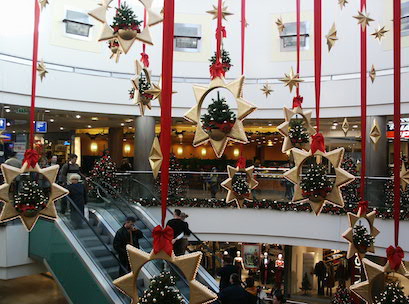 Spending across the economy has grown at its fastest rate in seven years in the lead-up to Christmas, with economists hopeful the surge signals a profitable festive season for retailers.
Spending across the economy has grown at its fastest rate in seven years in the lead-up to Christmas, with economists hopeful the surge signals a profitable festive season for retailers.
The Commonwealth Bank’s Business Sales Indicator rose 1.2 per cent in trend terms in November, while the previous month’s result was also revised upwards from 0.4 per cent to 1.1 per cent.
The BSI measures the value of credit and debit card transactions processed through the bank’s merchant facilities.
CommSec senior economist Sevanth Sebastian said spending had clearly bounced back from the uncertainty of the Brexit vote and the US and federal elections.
He said the figures indicated the 0.5 per cent slump in September quarter gross domestic product, reported earlier this month, was likely to be a minor blip on the radar.
“The Australian economy is in good shape, consumers are confident, and the outlook for 2017 remains bright, Mr Sebastian said.
“It’s unlikely that we will be heading for a second GDP dip and a technical recession.”
He also noted that figures were good news for retailers in the lead up to Christmas.
“The Christmas period is upon us and there are signs that retail spending has lifted in the last few weeks, a positive sign for Australian businesses leading into the New Year,” Sebastian said.
Spending rose across 16 of 19 government sectors in November, led by a 4.5 per cent rise in government services spending and 3.6 per cent rise in amusement and entertainment.
Across states and territories spending was also up in the month, with NSW recording the strongest monthly rise of 1.8 per cent.
Meanwhile, Economists are warning both sides of politics to get their act together on budget repair, insisting it’s inevitable Australia will lose its triple-A credit rating.
Economic growth forecasts have been significantly downgraded in the federal government’s mid-year budget update on Monday, following shockingly weak September quarter growth figures.
Real GDP is expected to come in at two per cent in 2016/17, compared to 2.5 per cent in the May budget.
It’s now forecast to remain below trend at 2.75 per cent in 2017/18 before picking up to three per cent in 2018/19, after the national accounts showed the economy shrank by 0.5 per cent in the September quarter, posting its worst performance since the global financial crisis.
While the update shows a slight improvement for the budget deficit in 2016/17, it’s expected to worsen by more than $10 billion over the forward estimates.
The long-awaited return to surplus is still projected for 2020/21.
That’s possible, but unlikely, AMP chief economist Shane Oliver says.
“If I was going to bet on it I’d say it’d be a year or two later,” he told AAP.
Dr Oliver believes Treasury’s forecasts on wages growth – projected to top three per cent by 2018/19 – are too optimistic.
On top of that, spending remains too high and iron ore prices are unlikely to remain at current highs.
It’s a matter of when, not if, Australia loses its triple-A rating. “We’re seeing bigger deficits for longer than we saw as a result of the 1990s recession which is a poor indictment on our ability to control spending and balance the budget.
“Sooner or later, we will get downgraded.”
Ratings agencies Standard & Poor’s, Fitch and Moody’s have kept Australia’s rating at triple-A following Monday’s update.
HSBC chief economist Paul Bloxham says the government has more work to do on budget repair.
“There’s more adjustment that needs to be made in terms of spending cuts and tax reform to get more revenue out of the tax system,” he said.
“Otherwise, ultimately Australia may very well lose its triple-A rating.”
Treasurer Scott Morrison and Finance Minister Mathias Cormann said the economy was continuing its transition in the wake of the mining investment boom, despite the downward revision to growth forecasts.
“Economic growth is expected to increase over the forecast period, as the drag from the decline in mining investment dissipates and the economy transitions to broader-based growth, supported by historically low interest rates and a lower Australian dollar,” they said.
“To support economic growth the government will continue to implement our national plan for jobs and growth.”
AAP
Access exclusive analysis, locked news and reports with Inside Retail Weekly. Subscribe today and get our premium print publication delivered to your door every week.





